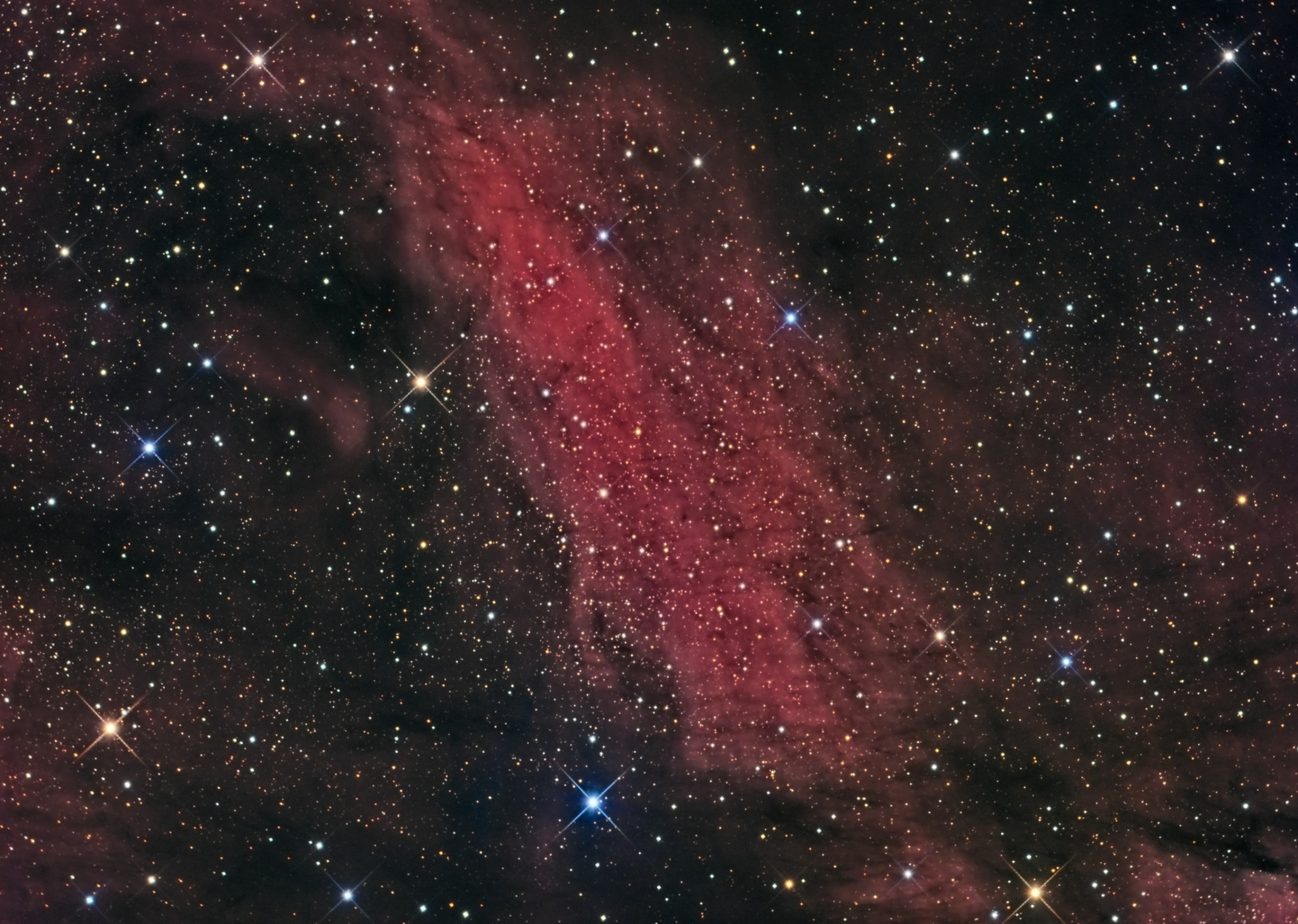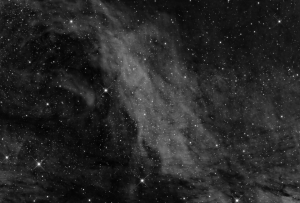Sh2-119, The Fireball XL5 Nebula
 Click image for full size version
Click image for full size version
August 7, 2016
This patch of glowing hydrogen lies “beneath” (so more or less east) of the Pelican Nebula. Although it is captured in many images that I’ve seen of this region, I’ve only seen a few where this patch is the main subject of the image. It is catalogued as LBN400 and Sh2-119. Since it is part of the complex around the North American Nebula, it’s distance is on the order of 1,800 light years.
When I initially couldn’t find a catalogue number for this object, I asked Gail and my daughter Chelsea help me name this nebula. We quickly landed on “Fireball XL5 Nebula” in honour of the Thunderbirds’ space ship. One of the many, many things that my wife, Gail, and I have in common is that we both loved The Thunderbirds growing up (“Filmed in SUPERMARIONATION”).
 The above image blends the red, green and blue colour channels with data collected through a deep red H-alpha filter. The black and white image at right shows the H-alpha data on its own. A full size H-alpha image is available by clicking on the image.
The above image blends the red, green and blue colour channels with data collected through a deep red H-alpha filter. The black and white image at right shows the H-alpha data on its own. A full size H-alpha image is available by clicking on the image.
Tekkies:
SBIG STL-11000M camera, Baader Ha, R, G and B filters, 10″ f/6.8 ASA astrograph, Paramount MX. Guided with QHY5 guide camera and 80 mm f/6 Stellar-Vue refractor. Acquisition, guiding and mount control with TheSkyX. Focusing with FocusMax. Automation with CCDCommander. All preprocessing and post-processing in PixInsight. Shot from my SkyShed in Guelph, Ontario. Nearly full Moon for Ha and little moonlight for RGB. Good to excellent transparency and poor to good seeing throughout acquisition.
12x15m R, 6x15mG, 5x15mB and 25x20m Ha unbinned frames (total=14hr05m).
HaRGB
Creation and cleanup: Ha, R, G and B masters were cropped and processed separately with DBE. R, G and B were combined to make an RGB image which was processed with ColourCalibration. The NB-RGBCombine Script was applied with default settings to produce a linear HaRGB image.
Linear Noise Reduction: MultiscaleLinearTransform was used to reduce noise in the background areas. Layer settings for threshold and strength: Layer 1: 3.0, 0.5 Layer 2: 2.0, 0.35 Layer 3: 1.0, 0.2 Layer 4: 0.5, 0.1
Stretching: HistogramTransformation was applied to make a pleasing yet bright image.
Synthetic Luminance and H-alpha only:
Creation and cleanup of SynthL: The cleaned up Ha, R,G and B masters were combined using the ImageIntegration tool (average, additive with scaling, noise evaluation, iterative K-sigma / biweight midvariance, no pixel rejection).
Deconvolution: A copy of the image was stretched to use as a deconvolution mask. A star mask was made from unstretched SynthL to use as a local deringing support. Deconvolution was applied (80 iterations, regularized Richardson-Lucy, external PSF made using DynamicPSF tool with about 20 stars; local deringing at 70% and global dark deringing at 0.03).
Linear Noise Reduction: MultiscaleLinearTransform was applied to reduce the noise. Layer settings for threshold and strength: Layer 1: 3.0, 0.5 Layer 2: 2.0, 0.35 Layer 3: 1.0, 0.2 Layer 4: 0.5, 0.1
Stretching: HistogramTransformation was applied to make a pleasing yet bright image. TGV Noise was applied and the image was re-stretched to reset the black point.
Combining SynthL with HaRGB:
The luminance channel of the HaRGB image was extracted, processed and then added back into the HaRGB image as follows:
1. Extract luminance from the HaRGB image.
2. Apply LinearFit using SynthL as the reference.
3. Use ChannelCombination in Lab mode to replace the HaRGB’s luminance with the fitted luminance from step 2.
4. LRGBCombine was then used to make a SynthLHaRGB image.
Final Processing of HaRGB and H-alpha only:
MorphologicalTransformation was applied in Morphological Selection mode to slightly shrink large and medium bright stars. Background, stars and nebula brightness and contrast (HaRGB and Ha-only), and saturation (HaRGB) were adjusted in several iterations using Curves with masks as required.
At this point, I wasn’t completely happy with the colours, so I made another version using the H-alpha only in the SynthL channel. I blended the result of the two versions to make the final image.
Image scale is about 1.1 arcsec per pixel for this camera / telescope combination.







Leave A Comment